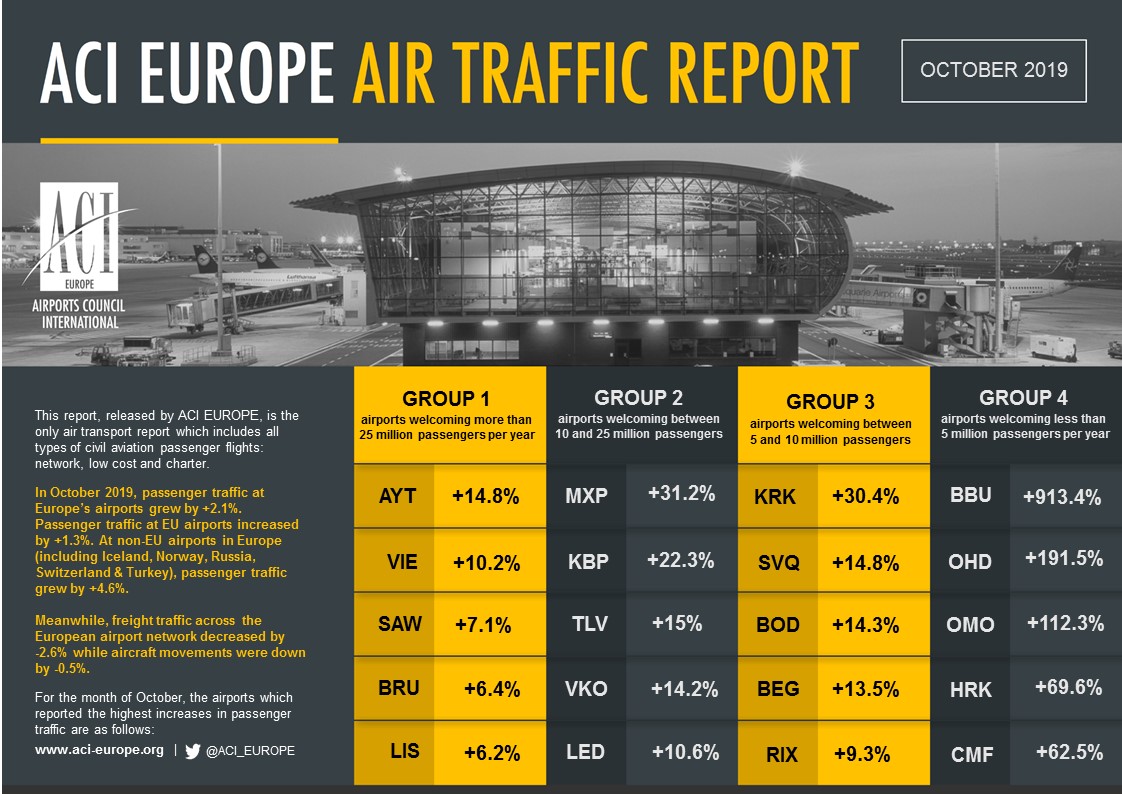Passenger traffic at +2.1% & Freight at -2.6% in October
17 December 2019Brussels - European airport trade body, ACI EUROPE today released its latest air traffic report for October 2019, measuring all of commercial aviation flights: full service, regionals, low cost and charter.
Passenger traffic across the European airport network increased by +2.1% in October. Although only a notch down from September (+2.2%), this marks the weakest monthly performance so far in 2019.
Meanwhile, freight traffic kept falling for the 12th consecutive month at
-2.6% (compared with -2.8% in September) and aircraft movements turned negative for the first time this year at -0.5%.
NON-EU MARKET LEADING TRAFFIC GROWTH
The increase in European passenger traffic was largely driven by non-EU airports at +4.6%, an improvement over September (+3%).
Such performance reflected double-digit increases at airports in Ukraine, Montenegro, North Macedonia, Albania, Bosnia-Herzegovina, Serbia, Israel and Armenia – as well as growth (although more moderate) at airports in Russia, Moldova and Turkey. Conversely, passenger traffic kept falling in Iceland following the bankruptcy of WOW last Spring, with Keflavik airport (-34.6%) experiencing a massive decrease. Airports in Switzerland and Georgia also posted (much smaller) decreases in passenger traffic, while Norwegian airports experienced weak growth.
Accordingly, the best passenger traffic performances came from the following capital & larger non-EU airports: Kyiv-Boryspil (+22.3%), Tirana (+20%), Tel Aviv (+15%), Antalya (+14.8%), Yerevan (+14.8%), Sarajevo (+14.3%), Moscow-Vnukovo (+14.2%), Belgrade (+13.5%) and Skopje (+13.1%).
CAPACITY RESTRAINT & AIRLINE FAILURES LIMIT EU MARKET GAINS
Passenger traffic growth at EU airports kept moderating in October, only increasing by +1.3% (down from +2% the previous month).
This reflected airlines generally limiting capacity expansion, industrial action in Germany & Italy - as well as the full impact of the collapse last September of Aigle Azur, XL Airways, Adria Airways and Thomas Cook. These airline failures particularly hit Ljubljana (-38.5%), East Midlands (-13.9%), Glasgow (-13%), Paris-Orly (-12.4%), Newcastle (-7.5%) Birmingham (-3.6%) and airports serving the Canary islands (-6% collectively for Las Palmas, Tenerife North, Tenerife South, Fuerteventura & Lanzarote).
Poland, Estonia and Croatia were the only EU markets where airports achieved double-digit increases in passenger traffic – with airports in Hungary, Austria, the Czech Republic, Luxembourg, Malta, Latvia and Lithuania also seeing dynamic growth. Apart from Slovenia, airports in the UK, Germany, Sweden, Slovakia and Bulgaria posted passenger traffic losses - while those in France, the Netherlands and Denmark registered only marginal gains.
Amongst capital & larger EU airports, the highest increases in passenger volumes came from: Tallinn (+11.2%), Vienna (+10.2%), Budapest (+9.8%), Luxembourg (+9.7%), Riga (+9.3%), Malta (+8.6%), London-Luton (+8.4%), Warsaw (+8.2%) and Prague (+8.1%).
MAJORS SLIGHTLY IMPROVING & SMALLER REGIONALS DETERIORATING
Passenger traffic at the Majors (top 5 European airports) in October stood just below the industry average at +1.8%, slightly improving over the previous month (+1.2%). Paris-CDG once again achieved the best performance (+4.1%), closely followed by Istanbul (+3.3%) whose performance improved compared to September. Frankfurt (+1%) as well as capacity constrained London-Heathrow (+0.5%) and Amsterdam-Schiphol (+0.3%) grew at a slower pace.
Meanwhile, the performance of smaller regional airports (less than 5 million passengers) kept worsening at -1.3% (from -0.7% in September). 54% of them lost passenger traffic during October, compared to just 33% for the rest of the airport industry.
Amongst smaller regional airports, the highest increases came from: Kharkiv (+69.6%), Kutaisi (+44.6%), Nis (+43.9%), Zadar (+41.8%), Turku (+38.3%), Tivat (+33.1%), Memmingerberg (+25%) and Dubrovnik (+22.7%). Amongst larger ones (more than 5 million passengers), Krakow (+30.4%), Sevilla (+14.8%) and Bordeaux (+14.3%) came on top.
FREIGHT DOWNTURN – EU FOCUSED
As in preceding months, the downturn in freight traffic in October remained focused on EU airports (-3.4%), with non-EU airports still making gains (+1.4%).
Out of the top 10 European airports for freight, only 2 saw their traffic increase: Liège (+2.2%) and Luxembourg (+1.9%).
During October, airports welcoming more than 25 million passengers per year (Group 1), airports welcoming between 10 and 25 million passengers (Group 2), airports welcoming between 5 and 10 million passengers (Group 3) and airports welcoming less than 5 million passengers per year (Group 4) reported an average adjustment +2.1%, +3.2%, +1.3% and +0.4%.
The airports that reported the highest increases in passenger traffic during October are as follows:
GROUP 1: Antalya (+14.8%), Vienna (+10.2%), Istanbul SAW (+7.1%), Brussels (+6.4%) and Lisbon (+6.2%).
GROUP 2: Milan MXP (+31.2%), Kyiv KBP (+22.3%), Tel Aviv (+15%), Moscow VKO (+14.2%) and St Petersburg (+10.6%).
GROUP 3: Krakow (+30.4%), Sevilla (+14.8%), Bordeaux (+14.3%), Belgrade (+13.5%) and Riga (+9.3%).
GROUP 4: Bucharest BBU (+913.4%), Ohrid (+191.5%), Mostar (+112.3%), Kharkiv (+69.6%) and Chambery (+62.5%).


